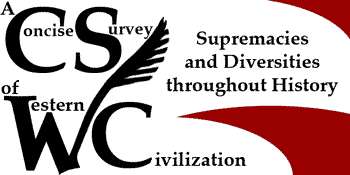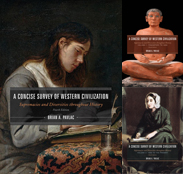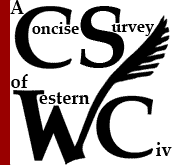Welcome
This Website accompanies the textbook, A Concise Survey of Western Civilization: Supremacies and Diversities Throughout History, 4th Edition, published by Rowman & Littlefield. (Images of the covers of earlier editions may be found here).
That's a long title for a short book.
This site offers numerous resources to anyone who wants to learn more about the past, whether using the Concise Western Civ book or not. Material may be used for non-profit, educational purposes.
Materials can be found by clicking on the available links. Yellow text in the red boxes and underlined blue text are hyperlinks. Clicking on the titles in the left-hand column links directly to a contents page for each chapter. Each page will offer, first, a brief theme and summary of the chapter and its sections. A list of key words, the main names, events, and facts for each section follows. Review Questions and other questions round out each Study Guide page.
In the navigation bar above in the header and below in the footer are these links:
- Home connects to this page;
- Study Guides lists the chapter pages described above;
- Primary Sources gives a list of chapter pages with links to historical evidence on the web and lists of printed recommended readings;
- Extras will lead to maps, timelines, and art; and take advantage of Students! How to Use this Website! and Tips for Teachers;
- Links provides the links to pages that connect to interesting and educational websites;
- Brian A. Pavlac connects to the author’s academic website in a new window.
Theme
The textbook, A Concise Survey of Western Civilization: Supremacies and Diversities throughout History uses interweaving themes to help to clarify the complexity of history: “supremacies and diversities.” The term “supremacies” focuses on the use of power to dominate societies, ranging from warfare to ideologies. Supremacy seeks stability, order, and amalgamation. In contrast, “diversities” encompasses the creative impulse that generates new ideas, as well as people’s efforts to define themselves as “different.” Diversity creates change, options, and divisions. The interaction of these trends help explain change in history.
Questions to keep in mind for “Supremacies:”
- How do the powerful conquer, control, and capitalize on other groups?
- How do elites maintain their superior status?
- In any particular time period, what mechanisms of power are operating through politics, economics, social structures, and religion?
- In any particular time period, how does art and literature reflect and reveal efforts by elites to create conformity?
Questions to keep in mind for “Diversities:”
- How do ethnic groups and/or classes preserve their identities?
- How do non-elites collaborate with or resist their lower status?
- How do the new ideas and technologies change dominant social and political structures?
- In any particular time period, how does art and literature reflect and reveal efforts by elites to create conformity?
Links specific to previous editions may no longer work. For more information about the textook and this website, click here.




